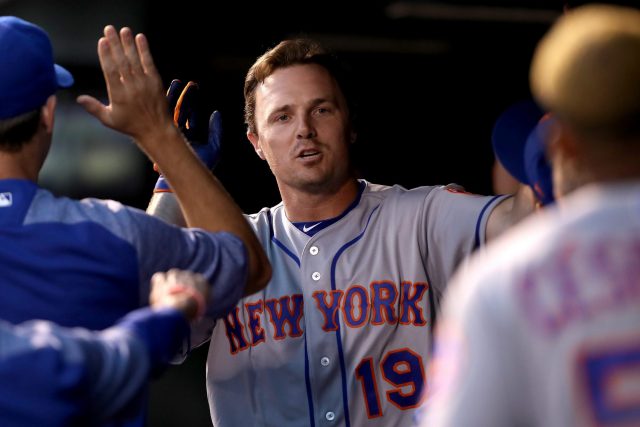New York Mets: Jay Bruce Trade Emphasizes Frugality

The New York Mets recent trade of Jay Bruce has shed light on a frugal and hypocritical trade deadline approach.
The New York Mets have often been criticized for their finances. After increasing payroll over the past few seasons, the team has seemingly gone back to their old ways, most notably in their three trades over the past month. Jay Bruce being shipped to Cleveland only further highlights the club’s frugality.
The Mets sent outfielder Jay Bruce to the Cleveland Indians in a trade that saw right hander Ryder Ryan go back to New York. Ryan, a 30th round draft choice in 2016, has pitched to a 4.79 ERA in A ball thus far in 2017. He has limited experience as a pitcher after playing the field mostly in college at North Carolina. He was not considered one of the Indians top 30 best prospects.
Yes, that is all the Mets managed to return for their current homerun and RBI leader. More than worthy of note is that Cleveland will pick up the reminder of Bruce’s salary (about $4 million), just like Boston did with Addison Reed and Tampa Bay with Lucas Duda.
The Mets unwillingness to eat salary to return better prospects contradicts a report by Ken Rosenthal from last month. Rosenthal is one of the most widely respected reporters in the business and questioning his sources likely wouldn’t be wise. The Mets have been known to be stingy with their checkbook in the past, so interpret their unwillingness to spend as you will.
[sc name=”Mets Center” ]The Indians entered the season with championship aspirations after falling just one game short in 2016. After injuries to outfielders Michael Brantley and Lonnie Chisenhall, it was clear they were in need of a boost to their outfield.
Although power is not in high demand across the league (which diminishes Bruce’s value to an extent), his veteran and middle of the order presence should have given the Mets some leverage in negotiating. Instead, they chose not eat any salary, and were unable to return a top 30 prospect from a system that wasn’t even one of baseball’s ten best, as ranked by MLB Pipeline’s Jim Callis.
Should the Mets have kept Bruce, they could have issued him a qualifying offer after the season. If he were to decline the QO and sign a contract of $50 million or more, the Mets would be awarded a second and fifth round draft choice under the new collective bargaining agreement.
[sc name=”Mets Link Related” link=”https://elitesportsny.com/2017/08/09/new-york-mets-reveal-jerseys-nicknames-for-mlb-players-weekend/” text=”Mets Reveal Jerseys, Nicknames for Players’ Weekend” ]If he were to decline and sign a contract for less than $50 million, the Mets would net a third round pick. The old system yielded a first round pick, which they were awarded when Daniel Murphy signed in Washington, for example. Either way, the draft choice the Mets would have acquired arguably would have held more value than the former 30th round draft choice they just netted from the Indians.
What makes this even more embarrassing is the money that will come off the books for the Mets after the season. Duda, Reed and Bruce were already positioned to enter free agency, while Curtis Granderson, Neil Walker, Jose Reyes, and Asdrubal Cabrera ($2 million buy-out clause) are all playing on expiring contracts.
The lack of spending is worrying.
Look, it’s no secret that 2017 is a lost year and ticket sales, along various other revenue streams are going to be down. However, after the Mets acquired A.J. Ramos from Miami, the message was clear that the team planned to contend in 2018.
The New York Mets will have (should have) plenty of cash to spend in the offseason. If they’re serious about making a push for October next season, it would be in their best interests to spend like a team playing in the world’s largest media market.
[sc name=”Mets Link Next” link=”https://elitesportsny.com/2017/08/09/new-york-mets-trade-matt-harvey/” text=”The Mets Aren’t Ready to Trade Matt Harvey (Report)” ]Central jersey born and bred. Monmouth University alumnus. Sports are not games, rather ways of life. Twitter: @Gcam92
Contact: G.Cambareri123@gmail.com






